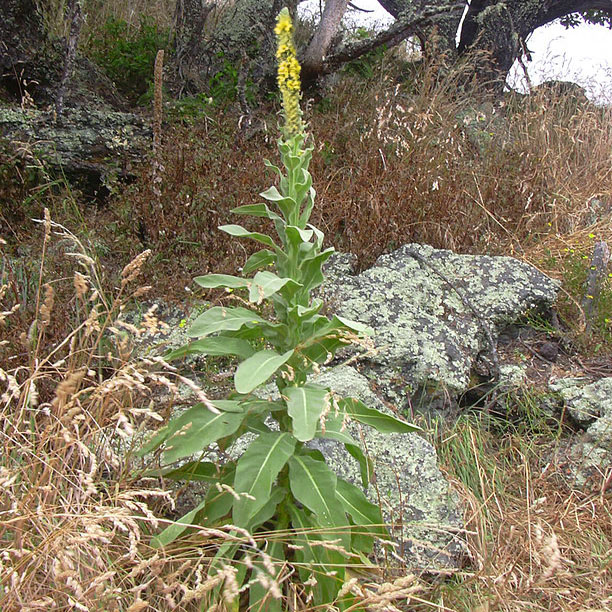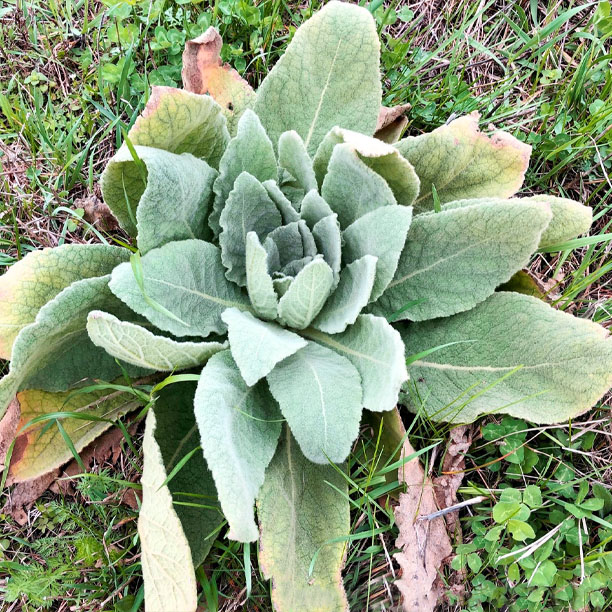Mullein
How To Identify
Mullein is fairly easy to identify because of its unique characteristics. The large oval leaves grow in a basil rosette around a central point and have no teeth around the edges but have very pronounced veining on the underside of the leaf. They are extremely soft and velvety and the entire plant, leaves, stalk and buds, are covered in a very soft fuzz of hair. Mullein grows low to the ground and has no flower stalk in it’s first year but in it’s second year, will grow a very tall, ridged flower stalk topped with a flowering spike that is packed with hop-like buds that will open into bright yellow flowers. The flowers will open at different times so the spike will almost never be completely covered in flowers. These stalks can grow anywhere between 2 – 7 feet tall.


Benefits
Mullein is considered to be anodyne, antiseptic and astringent but is really an excellent mucus expectorant and works wonders for chest congestion. Because of this it’s used primarily for respiratory illnesses but is also a decent immunity booster.
The flower stalk can be collected and dried to be used for primitive fire making as a spindle. It works well because the outside of the stalk get fairly hard while the inside is filled with a soft pith and because they grown very straight.
How To Find
Mullein likes open sunny areas and can often be found in fields, along paths and roadsides. It loves fringe areas like where woodlands and gravely areas meet. It can be found year-round but is best foraged from midspring through fall.
Gathering
Gathering is pretty simple because the entire plant, roots, leaves, stalk and flowers, are usable. We typically only collect the leaves for tincture or medicinal tea because this doesn’t hurt the plant, leaving it to be foraged again at a future time. We just cut the healthiest looking leaves off the stem.
How To Use
Mullein leaves can be used fresh or dried to make either a tincture or a medicinal tea. Our preferred method is to dry the leaves for use with tea. This method is not only easier but also more palatable. To prepare a cup, steep about 2 Tbsp. of dried mullein leaves by pouring boiling water over them and allowing to infuse for 15 – 20 minutes, then strain and serve or simply stuff a tea ball and steep in your favorite cup or mug.
A tincture can be made by stuffing a jar (or other container) with fresh mullein leaves and then toping it off with vodka. Some people prefer to use a high proof brandy because they enjoy the flavor. Allow this to sit on a widow sill or another sunny spot for at least two weeks and then filter the liquid and discard the leaves. This liquid tincture can then be taken, 1/4–3/4 teaspoon (1–4 ml) three to four times per day.
Preservation
To preserve mullein leaves, place them into a paper bag, or on a screen (window screen or similar) and allow them to dry in a dry dark place with good airflow. They can also be dehydrated using very low or no heat in a standard dehydrator or freeze dried. Oven drying isn’t recommended as the heat can damage the medicinal benefits. Another method of preserving is to make a tincture as described above. Because of the alcohol, tinctures can last on the shelf for years.